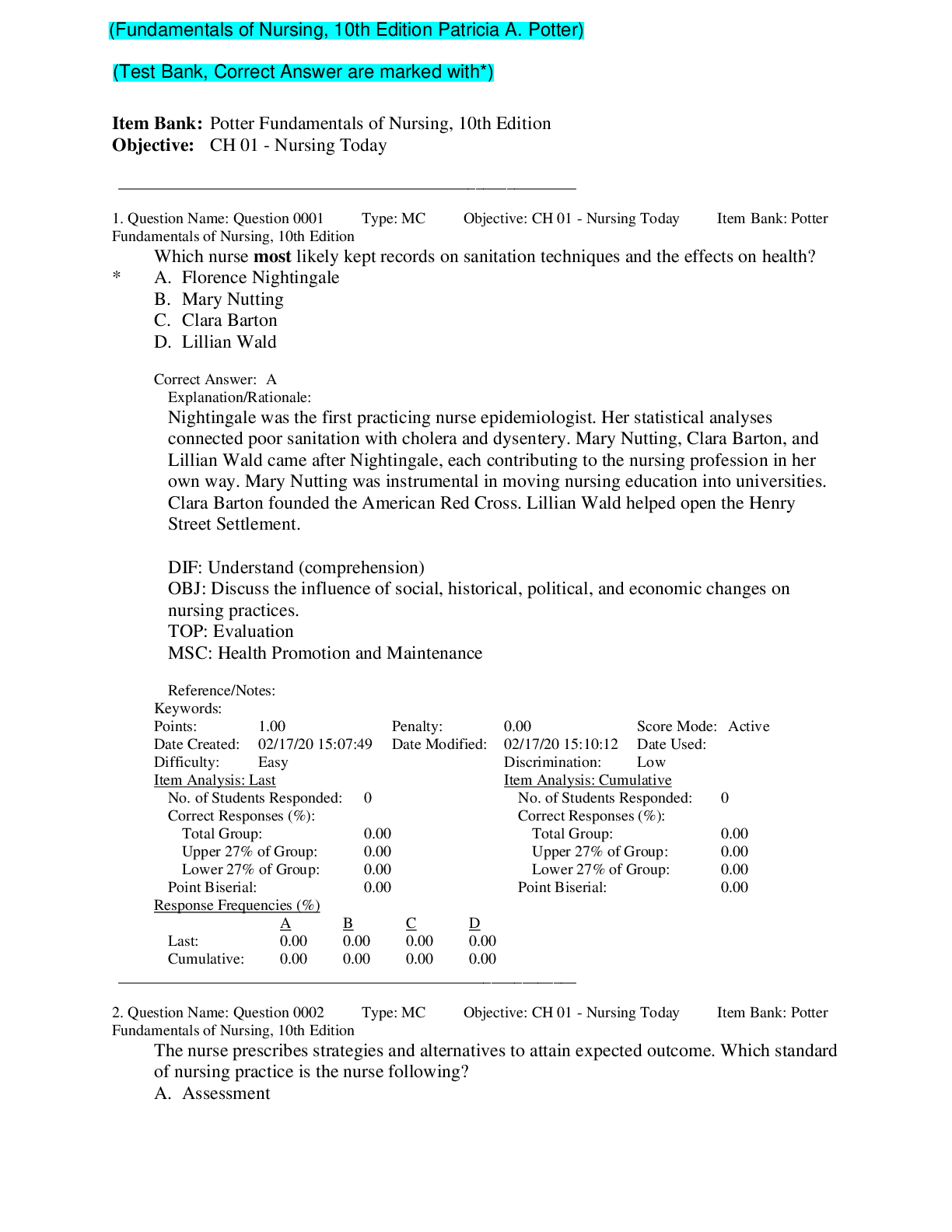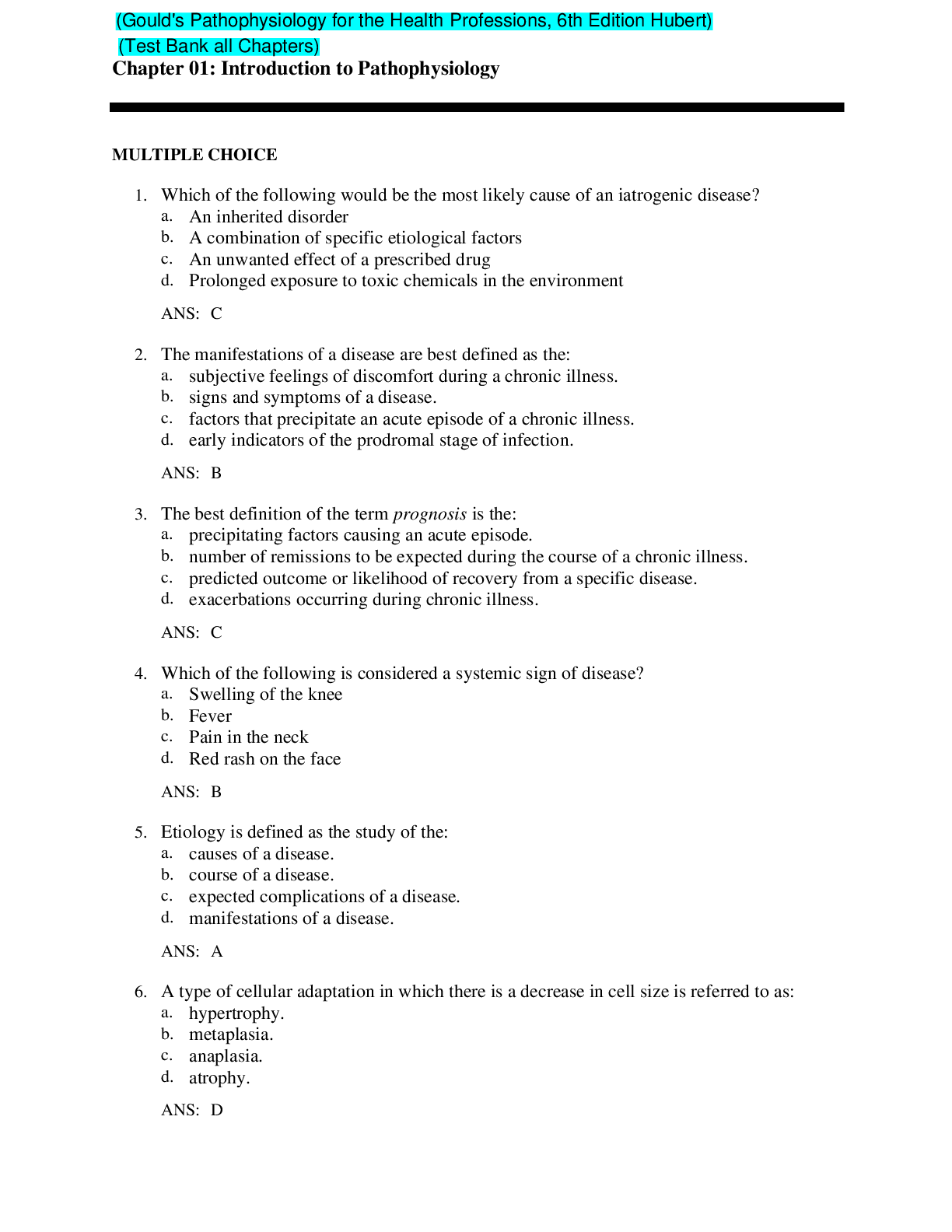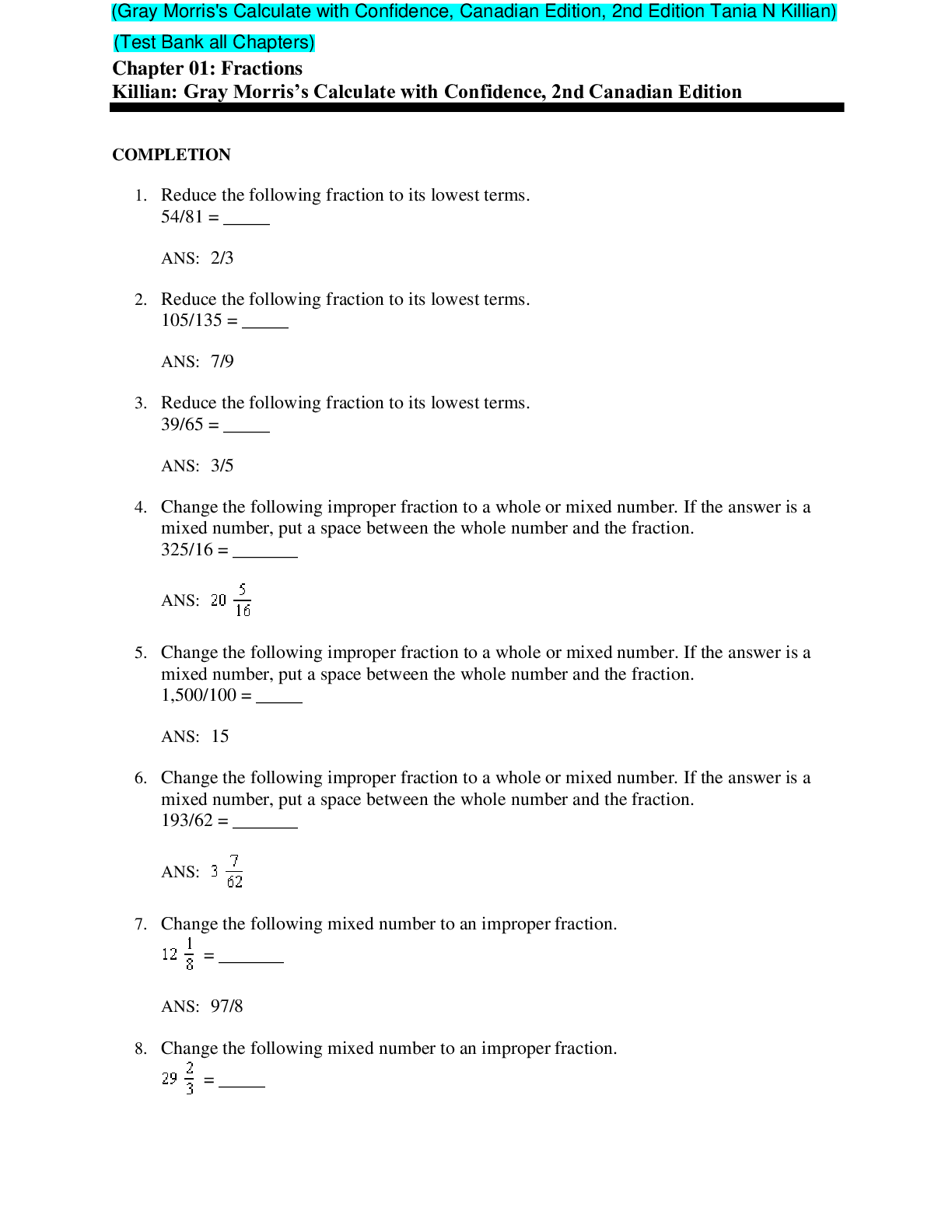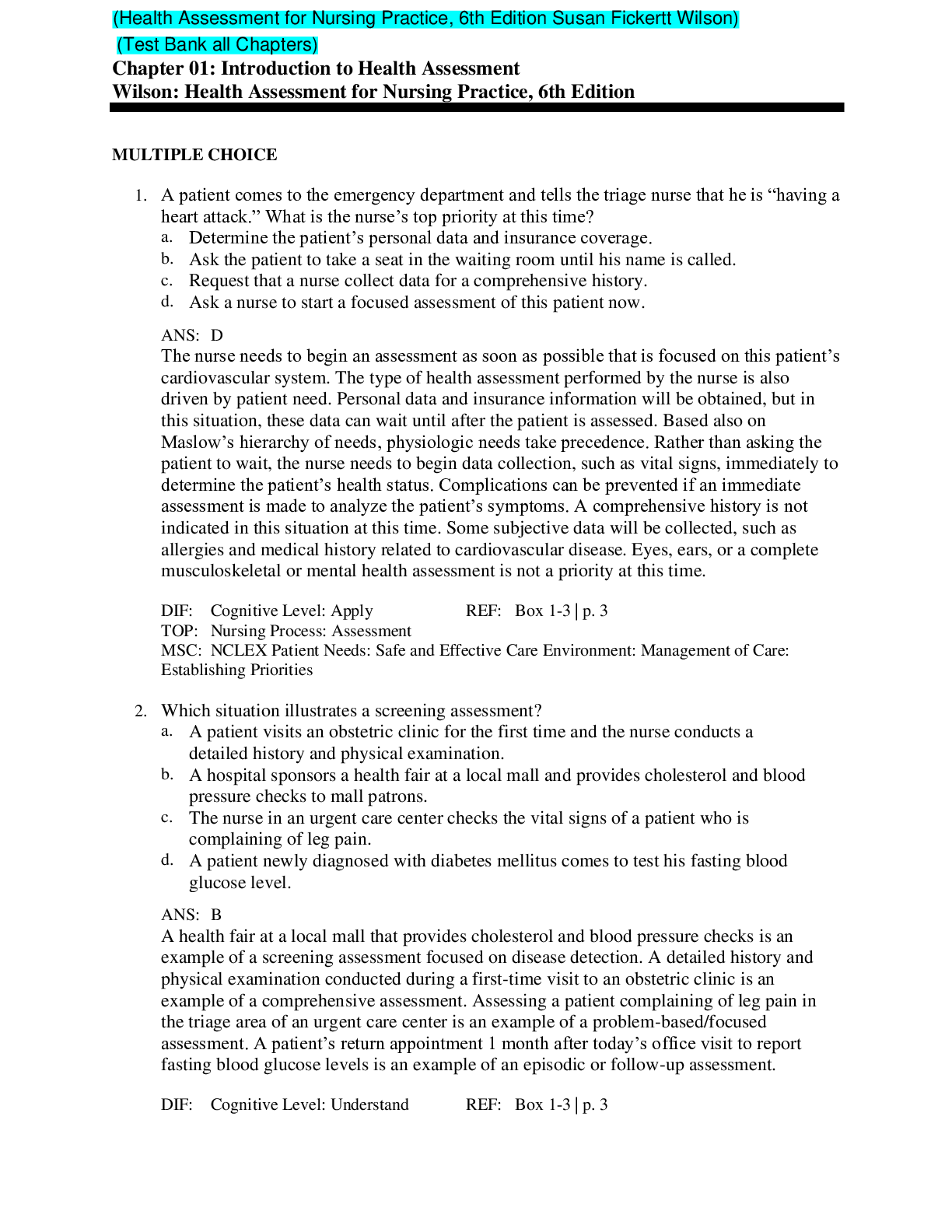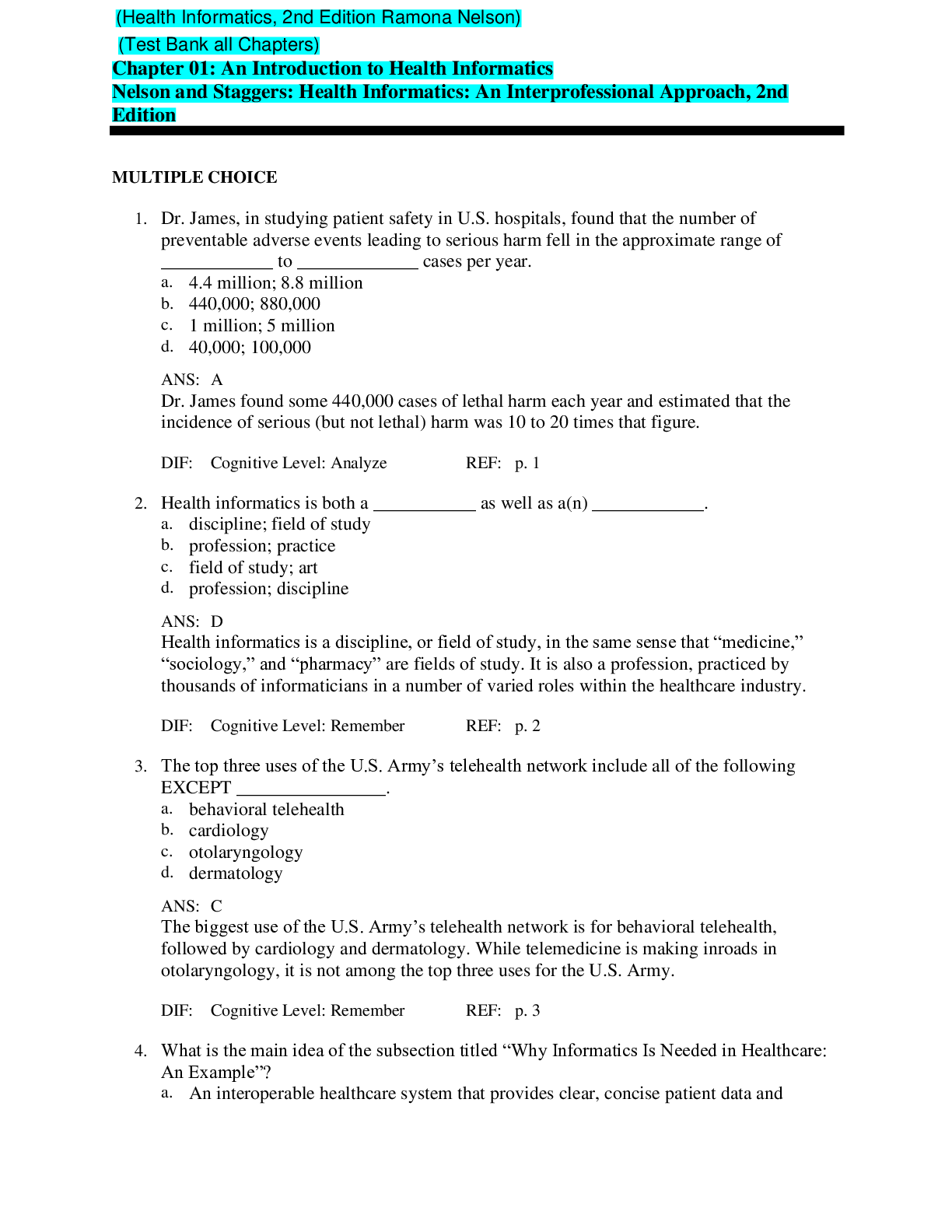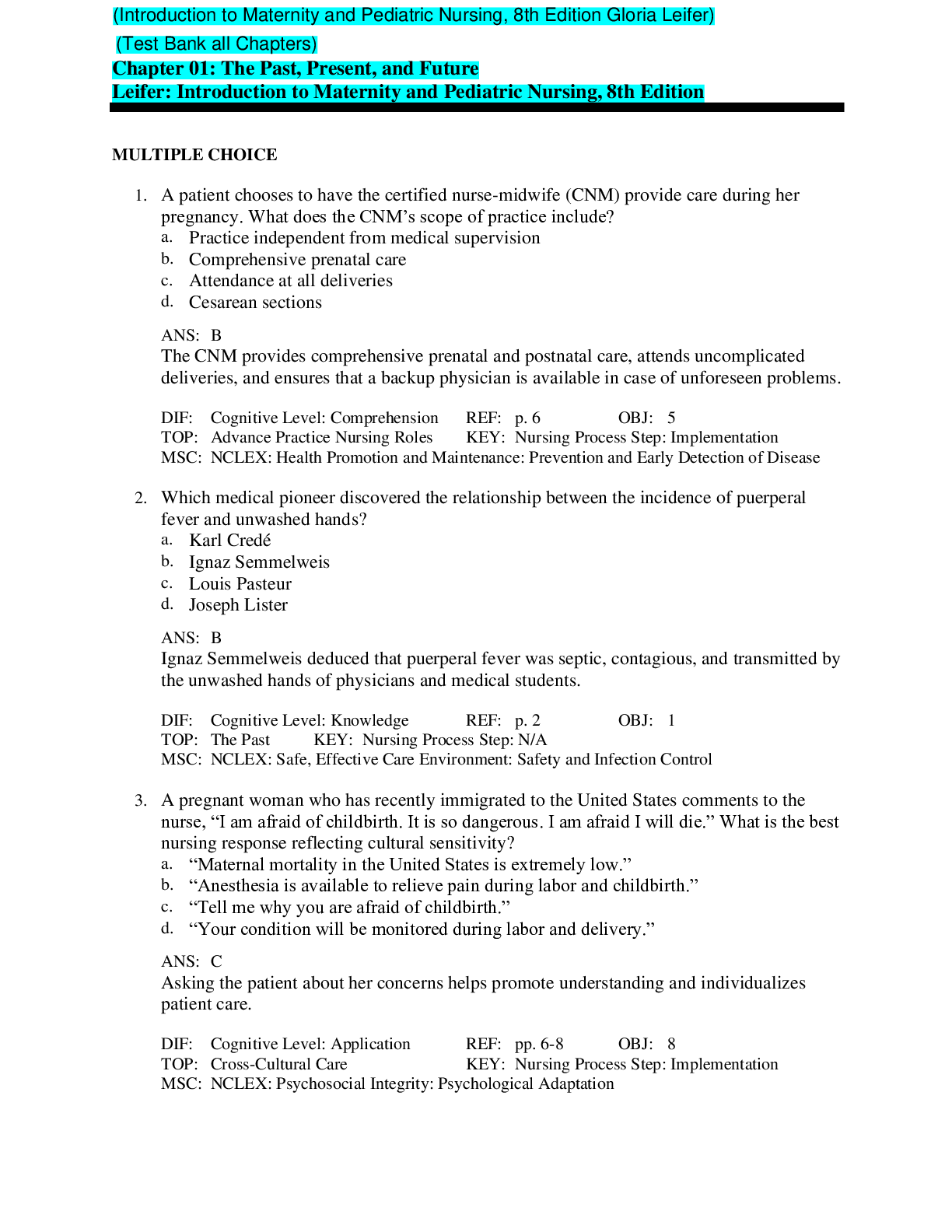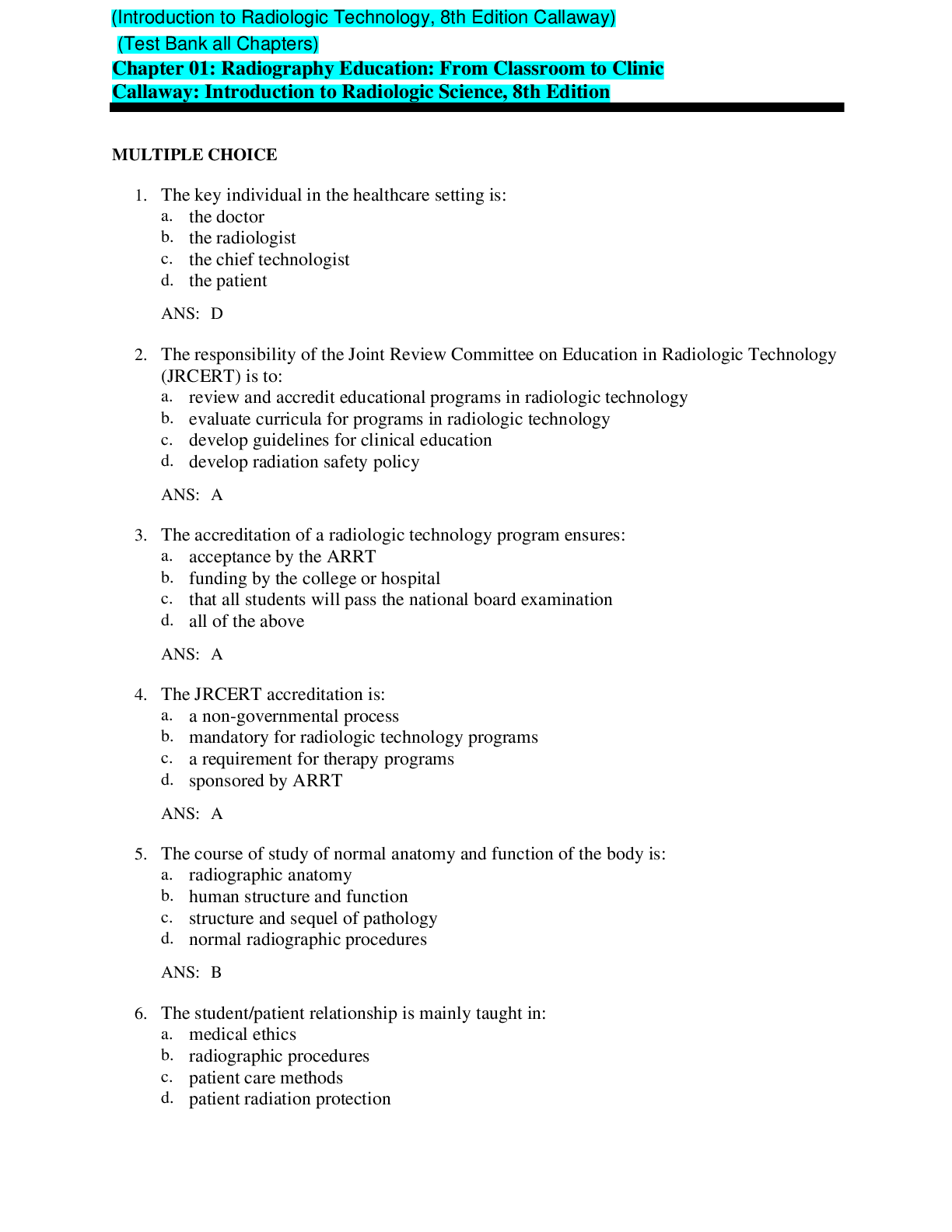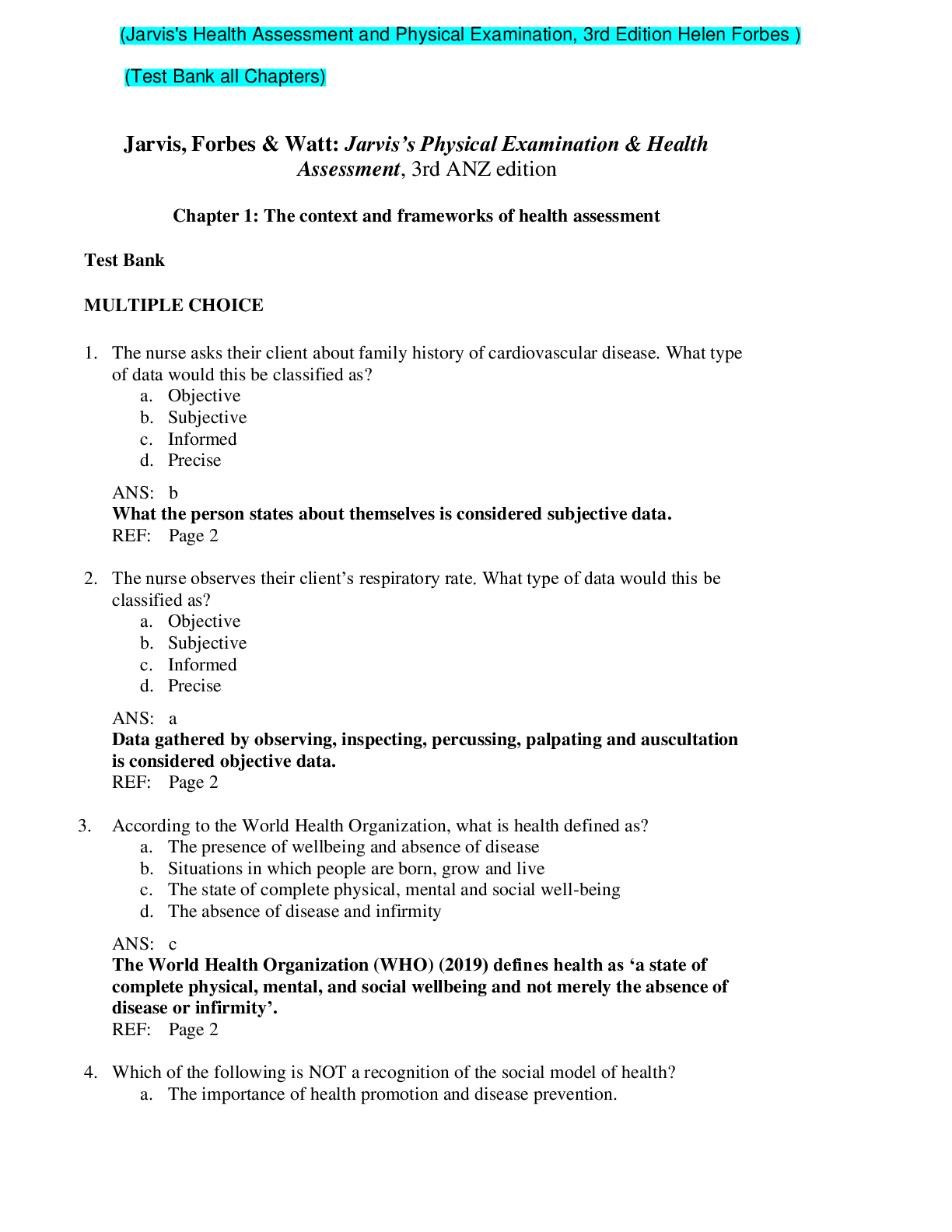Nursing Board Practice Exams Compilation
Document Content and Description Below
Nursing Board Practice Test Compilation Contents NURSING PRACTICE I: FOUNDATION OF NURSING PRACTICE.......................................................................... 4 NURSING PRACTICE II.... ....................................................15 NURSING PRACTICE III....................................................26 NURSING PRACTICE IV....................................................36 NURSING PRACTICE V.....................................................46 TEST I - Foundation of Professional Nursing Practice ....56 Answers and Rationale – Foundation of Professional Nursing Practice .........................................................66 TEST II - Community Health Nursing and Care of the Mother and Child ...........................................................74 Answers and Rationale – Community Health Nursing and Care of the Mother and Child .............................84 TEST III - Care of Clients with Physiologic and Psychosocial Alterations ................................................91 Answers and Rationale – Care of Clients with Physiologic and Psychosocial Alterations ................102 TEST IV - Care of Clients with Physiologic and Psychosocial Alterations ..............................................111 Answers and Rationale – Care of Clients with Physiologic and Psychosocial Alterations ................122 TEST V - Care of Clients with Physiologic and Psychosocial Alterations....................................................................133 Answers and Rationale – Care of Clients with Physiologic and Psychosocial Alterations ................144 PART III PRACTICE TEST I FOUNDATION OF NURSING .153 ANSWERS AND RATIONALE – FOUNDATION OF NURSING ..................................................................158 PRACTICE TEST II Maternal and Child Health...............162 ANSWERS AND RATIONALE – MATERNAL AND CHILD HEALTH.....................................................................167 MEDICAL SURGICAL NURSING .....................................173 ANSWERS AND RATIONALE – MEDICAL SURGICAL NURSING ..................................................................178 PSYCHIATRIC NURSING ................................................180 ANSWERS AND RATIONALE – PSYCHIATRIC NURSING .................................................................................185 FOUNDATION OF PROFESSIONAL NURSING PRACTICE188 ANSWER KEY - FOUNDATION OF PROFESSIONAL NURSING PRACTICE.................................................. 199 COMMUNITY HEALTH NURSING AND CARE OF THE MOTHER AND CHILD.................................................... 200 ANSWER KEY: COMMUNITY HEALTH NURSING AND CARE OF THE MOTHER AND CHILD.......................... 211 Comprehensive Exam 1................................................ 213 CARE OF CLIENTS WITH PHYSIOLOGIC AND PSYCHOSOCIAL ALTERATIONS...................................... 222 ANSWER KEY: CARE OF CLIENTS WITH PHYSIOLOGIC AND PSYCHOSOCIAL ALTERATIONS ......................... 234 Nursing Practice Test V ................................................ 235 Nursing Practice Test V ................................................ 245 TEST I - Foundation of Professional Nursing Practice .. 255 Answers and Rationale – Foundation of Professional Nursing Practice ....................................................... 265 TEST II - Community Health Nursing and Care of the Mother and Child ......................................................... 273 Answers and Rationale – Community Health Nursing and Care of the Mother and Child ........................... 283 TEST III - Care of Clients with Physiologic and Psychosocial Alterations .............................................. 290 Answers and Rationale – Care of Clients with Physiologic and Psychosocial Alterations ................ 301 TEST IV - Care of Clients with Physiologic and Psychosocial Alterations .............................................. 310 Answers and Rationale – Care of Clients with Physiologic and Psychosocial Alterations ................ 321 TEST V - Care of Clients with Physiologic and Psychosocial Alterations.................................................................... 332 Answers and Rationale – Care of Clients with Physiologic and Psychosocial Alterations ................ 343 PART III ......................................................................... 352 PRACTICE TEST I FOUNDATION OF NURSING .............. 352 ANSWERS AND RATIONALE – FOUNDATION OF NURSING .................................................................. 357 PRACTICE TEST II Maternal and Child Health............... 3612 ANSWERS AND RATIONALE – MATERNAL AND CHILD HEALTH.....................................................................366 MEDICAL SURGICAL NURSING .....................................372 ANSWERS AND RATIONALE – MEDICAL SURGICAL NURSING ..................................................................377 PSYCHIATRIC NURSING ................................................379 ANSWERS AND RATIONALE – PSYCHIATRIC NURSING .................................................................................384 FUNDAMENTALS OF NURSING PART 1 ........................387 FUNDAMENTALS OF NURSING PART 2 ........................392 ANSWERS and RATIONALES for FUNDAMENTALS OF NURSING PART 2......................................................397 FUNDAMENTALS OF NURSING PART 3 ........................401 ANSWERS and RATIONALES for FUNDAMENTALS OF NURSING PART 3......................................................405 MATERNITY NURSING Part 1........................................409 ANSWERS and RATIONALES for MATERNITY NURSING Part 1........................................................................418 MATERNITY NURSING Part 2........................................428 Answer for maternity part 2 ....................................433 PEDIATRIC NURSING ....................................................434 ANSWERS and RATIONALES for PEDIATRIC NURSING .................................................................................439 COMMUNITY HEALTH NURSING Part 1........................444 COMMUNITY HEALTH NURSING Part 2........................454 MEDICAL SURGICAL NURSING Part 1........................... 475 ANSWERS and RATIONALES for MEDICAL SURGICAL NURSING Part 1........................................................ 479 MEDICAL SURGICAL NURSING Part 2........................... 481 MEDICAL SURGICAL NURSING Part 2....................... 485 ANSWERS and RATIONALES for MEDICAL SURGICAL NURSING Part 2........................................................ 489 MEDICAL SURGICAL NURSING Part 3........................... 491 ANSWERS and RATIONALES for MEDICAL SURGICAL NURSING Part 3........................................................ 495 PSYCHIATRIC NURSING Part 1...................................... 497 ANSWERS and RATIONALES for PSYCHIATRIC NURSING Part 1........................................................................ 502 PSYCHIATRIC NURSING Part 2...................................... 504 ANSWERS and RATIONALES for PSYCHIATRIC NURSING Part 2........................................................................ 509 PSYCHIATRIC NURSING Part 3...................................... 512 ANSWERS and RATIONALES for PSYCHIATRIC NURSING Part 3........................................................................ 516 PROFESSIONAL ADJUSTMENT...................................... 519 LEADERSHIP and MANAGEMENT................................. 522 NURSING RESEARCH Part 1.......................................... 532 NURSING RESEARCH Part 2.......................................... 542 Nursing Research Suggested Answer Key ................ 54634 NURSING PRACTICE I: FOUNDATION OF NURSING PRACTICE SITUATION: Nursing is a profession. The nurse should have a background on the theories and foundation of nursing as it influenced what is nursing today. 1. Nursing is the protection, promotion and optimization of health and abilities, prevention of illness and injury, alleviation of suffering through the diagnosis and treatment of human response and advocacy in the care of the individuals, families, communities and the population. This is the most accepted definition of nursing as defined by the: a. PNA b. ANA c. Nightingale d. Henderson 2. Advancement in Nursing leads to the development of the Expanded Career Roles. Which of the following is NOT an expanded career role for nurses? a. Nurse practitioner b. Nurse Researcher c. Clinical nurse specialist d. Nurse anaesthesiologist 3. The Board of Nursing regulated the Nursing profession in the Philippines and is responsible for the maintenance of the quality of nursing in the country. Powers and duties of the board of nursing are the following, EXCEPT: a. Issue, suspend, revoke certificates of registration b. Issue subpoena duces tecum, ad testificandum c. Open and close colleges of nursing d. Supervise and regulate the practice of nursing 4. A nursing student or a beginning staff nurse who has not yet experienced enough real situations to make judgments about them is in what stage of Nursing Expertise? a. Novice b. Newbie c. Advanced Beginner d. Competent 5. Benner’s “Proficient” nurse level is different from the other levels in nursing expertise in the context of having: a. the ability to organize and plan activities b. having attained an advanced level of education c. a holistic understanding and perception of the client d. intuitive and analytic ability in new situations SITUATION: The nurse has been asked to administer an injection via Z TRACK technique. Questions 6 to 10 refer to this. 6. The nurse prepares an IM injection for an adult client using the Z track technique. 4 ml of medication is to be administered to the client. Which of the following site will you choose? a. Deltoid b. Rectus femoris c. Ventrogluteal d. Vastus lateralis 7. In infants 1 year old and below, which of the following is the site of choice for intramuscular Injection? a. Deltoid b. Rectus femoris c. Ventrogluteal d. Vastus lateralis 8. In order to decrease discomfort in Z track administration, which of the following is applicable? a. Pierce the skin quickly and smoothly at a 90 degree angle b. Inject the medication steadily at around 10 minutes per millilitre c. Pull back the plunger and aspirate for 1 minute to make sure that the needle did not hit a blood vessel d. Pierce the skin slowly and carefully at a 90 degree angle 9. After injection using the Z track technique, the nurse should know that she needs to wait for a few seconds before withdrawing the needle and this is to allow the medication to disperse into the muscle tissue, thus decreasing the client’s discomfort. How many seconds should the nurse wait before withdrawing the needle? a. 2 seconds5 b. 5 seconds c. 10 seconds d. 15 seconds 10. The rationale in using the Z track technique in an intramuscular injection is: a. It decreases the leakage of discolouring and irritating medication into the subcutaneous tissues b. It will allow a faster absorption of the medication c. The Z track technique prevent irritation of the muscle d. It is much more convenient for the nurse SITUATION: A Client was rushed to the emergency room and you are his attending nurse. You are performing a vital sign assessment. 11. All of the following are correct methods in assessment of the blood pressure EXCEPT: a. Take the blood pressure reading on both arms for comparison b. Listen to and identify the phases of Korotkoff’s sound c. Pump the cuff to around 50 mmHg above the point where the pulse is obliterated d. Observe procedures for infection control 12. You attached a pulse oximeter to the client. You know that the purpose is to: a. Determine if the client’s hemoglobin level is low and if he needs blood transfusion b. Check level of client’s tissue perfusion c. Measure the efficacy of the client’s antihypertensive medications d. Detect oxygen saturation of arterial blood before symptoms of hypoxemia develops 13. After a few hours in the Emergency Room, The client is admitted to the ward with an order of hourly monitoring of blood pressure. The nurse finds that the cuff is too narrow and this will cause the blood pressure reading to be: a. inconsistent b. low systolic and high diastolic c. higher than what the reading should be d. lower than what the reading should be 14. Through the client’s health history, you gather that the patient smokes and drinks coffee. When taking the blood pressure of a client who recently smoked or drank coffee, how long should the nurse wait before taking the client’s blood pressure for accurate reading? a. 15 minutes b. 30 minutes c. 1 hour d. 5 minutes 15. While the client has pulse oximeter on his fingertip, you notice that the sunlight is shining on the area where the oximeter is. Your action will be to: a. Set and turn on the alarm of the oximeter b. Do nothing since there is no identified problem c. Cover the fingertip sensor with a towel or bedsheet d. Change the location of the sensor every four hours 16. The nurse finds it necessary to recheck the blood pressure reading. In case of such re assessment, the nurse should wait for a period of: a. 15 seconds b. 1 to 2 minutes c. 30 minutes d. 15 minutes 17. If the arm is said to be elevated when taking the blood pressure, it will create a: a. False high reading b. False low reading c. True false reading d. Indeterminate 18. You are to assessed the temperature of the client the next morning and found out that he ate ice cream. How many minutes should you wait before assessing the client’s oral temperature? a. 10 minutes b. 20 minutes c. 30 minutes d. 15 minutes 19. When auscultating the client’s blood pressure the nurse hears the following: From 150 mmHg to 130 mmHg: Silence, Then: a thumping sound continuing down to 100 mmHg; muffled sound continuing down to 80 mmHg and then silence.6 What is the client’s blood pressure? a. 130/80 b. 150/100 c. 100/80 d. 150/100 20. In a client with a previous blood pressure of 130/80 4 hours ago, how long will it take to release the blood pressure cuff to obtain an accurate reading? a. 10-20 seconds b. 30-45 seconds c. 1-1.5 minutes d. 3-3.5 minutes Situation: Oral care is an important part of hygienic practices and promoting client comfort. 21. An elderly client, 84 years old, is unconscious. Assessment of the mouth reveals excessive dryness and presence of sores. Which of the following is BEST to use for oral care? a. lemon glycerine b. Mineral oil c. hydrogen peroxide d. Normal saline solution 22. When performing oral care to an unconscious client, which of the following is a special consideration to prevent aspiration of fluids into the lungs? a. Put the client on a sidelying position with head of bed lowered b. Keep the client dry by placing towel under the chin c. Wash hands and observes appropriate infection control d. Clean mouth with oral swabs in a careful and an orderly progression 23. The advantages of oral care for a client include all of the following, EXCEPT: a. decreases bacteria in the mouth and teeth b. reduces need to use commercial mouthwash which irritate the buccal mucosa c. improves client’s appearance and selfconfidence d. improves appetite and taste of food 24. A possible problem while providing oral care to unconscious clients is the risk of fluid aspiration to lungs. This can be avoided by: a. Cleaning teeth and mouth with cotton swabs soaked with mouthwash to avoid rinsing the buccal cavity b. swabbing the inside of the cheeks and lips, tongue and gums with dry cotton swabs c. use fingers wrapped with wet cotton washcloth to rub inside the cheeks, tongue, lips and ums d. suctioning as needed while cleaning the buccal cavity 25. Your client has difficulty of breathing and is mouth breathing most of the time. This causes dryness of the mouth with unpleasant odor. Oral hygiene is recommended for the client and in addition, you will keep the mouth moistened by using: a. salt solution b. petroleum jelly c. water d. mentholated ointment Situation – Ensuring safety before, during and after a diagnostic procedure is an important responsibility of the nurse. 26. To help Fernan better tolerate the bronchoscopy, you should instruct him to practice which of the following prior to the procedure? a. Clenching his fist every 2 minutes b. Breathing in and out through the nose with his mouth open c. Tensing the shoulder muscles while lying on his back d. Holding his breath periodically for 30 seconds 27. Following a bronchoscopy, which of the following complains to Fernan should be noted as a possible complication: a. Nausea and vomiting b. Shortness of breath and laryngeal stridor c. Blood tinged sputum and coughing d. Sore throat and hoarseness 28. Immediately after bronchoscopy, you instructed Fernan to: a. Exercise the neck muscles b. Refrain from coughing and talking7 c. Breathe deeply d. Clear his throat 29. Thoracentesis may be performed for cytologic study of pleural fluid. As a nurse your most important function during the procedure is to: a. Keep the sterile equipment from contamination b. Assist the physician c. Open and close the three-way stopcock d. Observe the patient’s vital signs 30. Right after thoracentesis, which of the following is most appropriate intervention? a. Instruct the patient not to cough or deep breathe for two hours b. Observe for symptoms of tightness of chest or bleeding c. Place an ice pack to the puncture site d. Remove the dressing to check for bleeding Situation: Knowledge of the acid-base disturbance and the functions of the electrolytes is necessary to determine appropriate intervention and nursing actions. 31. A client with diabetes milletus has a blood glucose level of 644 mg/dL. The nurse interprets that this client is at most risk for the development of which type of acid-base imbalance? a. Respiratory acidosis b. Respiratory alkalosis c. Metabolic acidosis d. Metabolic alkalosis 32. In a client in the health care clinic, arterial blood gas analysis gives the following results: pH 7.48, PCO2 32 mmHg, PO2 94 mmHg, HCO3 24 mEq/L. The nurse interprets that the client has which acid base disturbance? a. Respiratory acidosis b. Metabolic acidosis c. Respiratory alkalosis d. Metabolic alkalosis 33. A client has an order for ABG analysis on radial artery specimens. The nurse ensures that which of the following has been performed or tested before the ABG specimens are drawn? a. Guthrie test b. Romberg’s test c. Allen’s test d. Weber’s test 34. A nurse is reviewing the arterial blood gas values of a client and notes that the ph is 7.31, Pco2 is 50 mmHg, and the bicarbonate is 27 mEq/L. The nurse concludes that which acid base disturbance is present in this client? a. Respiratory acidosis b. Metabolic acidosis c. Respiratory alkalosis d. Metabolic alkalosis 35. Allen’s test checks the patency of the: a. Ulnar artery b. Carotid artery c. Radial artery d. Brachial artery Situation 6: Eileen, 45 years old is admitted to the hospital with a diagnosis of renal calculi. She is experiencing severe flank pain, nauseated and with a temperature of 39 0C. 36. Given the above assessment data, the most immediate goal of the nurse would be which of the following? a. Prevent urinary complication b. maintains fluid and electrolytes c. Alleviate pain d. Alleviating nausea 37. After IVP a renal stone was confirmed, a left nephrectomy was done. Her post-operative order includes “daily urine specimen to be sent to the laboratory”. Eileen has a foley catheter attached to a urinary drainage system. How will you collect the urine specimen? a. remove urine from drainage tube with sterile needle and syringe and empty urine from the syringe into the specimen container b. empty a sample urine from the collecting bag into the specimen container c. Disconnect the drainage tube from the indwelling catheter and allow urine to flow from catheter into the specimen container. d. Disconnect the drainage from the collecting bag and allow the urine to flow from the catheter into the specimen container.8 38. Where would the nurse tape Eileen’s indwelling catheter in order to reduce urethral irritation? a. to the patient’s inner thigh b. to the patient’ buttocks c. to the patient’s lower thigh d. to the patient lower abdomen 39. Which of the following menu is appropriate for one with low sodium diet? a. instant noodles, fresh fruits and ice tea b. ham and cheese sandwich, fresh fruits and vegetables c. white chicken sandwich, vegetable salad and tea d. canned soup, potato salad, and diet soda 40. How will you prevent ascending infection to Eileen who has an indwelling catheter? a. see to it that the drainage tubing touches the level of the urine b. change he catheter every eight hours c. see to it that the drainage tubing does not touch the level of the urine d. clean catheter may be used since urethral meatus is not a sterile area Situation: Hormones are secreted by the various glands in the body. Basic knowledge of the endocrine system is necessary. 41. Somatocrinin or the Growth hormone releasing hormone is secreted by the: a. Hypothalamus b. Posterior pituitary gland c. Anterior pituitary gland d. Thyroid gland 42. All of the following are secreted by the anterior pituitary gland except: a. Somatotropin/Growth hormone b. Thyroid stimulating hormone c. Follicle stimulating hormone d. Gonadotropin hormone releasing hormone 43. All of the following hormones are hormones secreted by the Posterior pituitary gland except: a. Vasopressin b. Anti-diuretic hormone c. Oxytocin d. Growth hormone 44. Calcitonin, a hormone necessary for calcium regulation is secreted in the: a. Thyroid gland b. Parathyroid gland c. Hypothalamus d. Anterior pituitary gland 45. While Parathormone, a hormone that negates the effect of calcitonin is secreted by the: a. Thyroid gland b. Parathyroid gland c. Hypothalamus d. Anterior pituitary gland Situation: The staff nurse supervisor requests all the staff nurses to “brainstorm” and learn ways to instruct diabetic clients on self-administration of insulin. She wants to ensure that there are nurses available daily to do health education classes. 46. The plan of the nurse supervisor is an example of a. in service education process b. efficient management of human resources c. increasing human resources d. primary prevention 47. When Mrs. Guevarra, a nurse, delegates aspects of the clients care to the nurse-aide who is an unlicensed staff, Mrs. Guevarra a. makes the assignment to teach the staff member b. is assigning the responsibility to the aide but not the accountability for those tasks c. does not have to supervise or evaluate the aide d. most know how to perform task delegated 48. Connie, the new nurse, appears tired and sluggish and lacks the enthusiasm she had six weeks ago when she started the job. The nurse supervisor should a. empathize with the nurse and listen to her b. tell her to take the day off c. discuss how she is adjusting to her new job d. ask about her family life 49. Process of formal negotiations of working conditions between a group of registered nurses and employer is9 a. grievance b. arbitration c. collective bargaining d. strike 50. You are attending a certification on cardiopulmonary resuscitation (CPR) offered and required by the hospital employing you. This is a. professional course towards credits b. in-service education c. advance training d. continuing education [Show More]
Last updated: 11 months ago
Preview 1 out of 546 pages
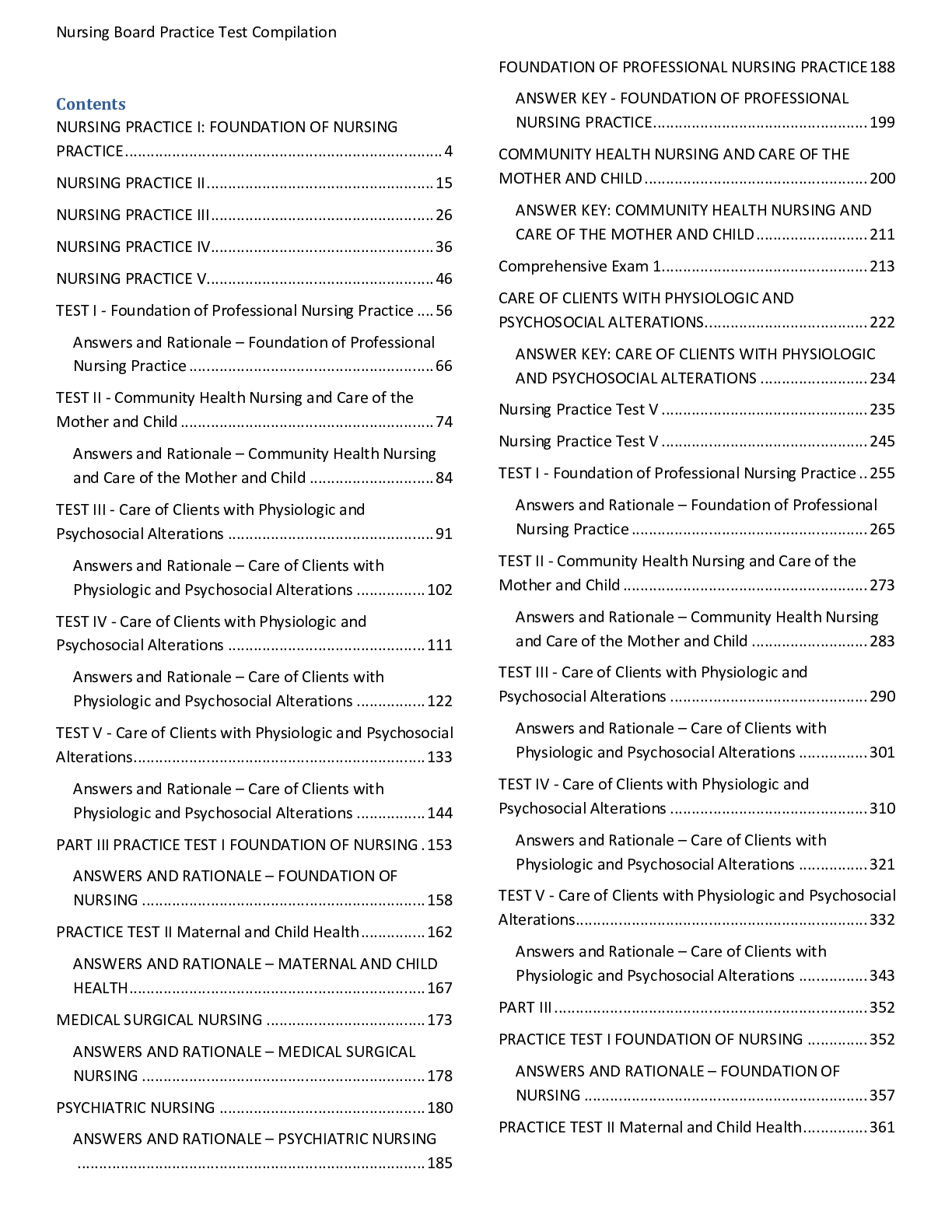
Reviews( 0 )
Document information
Connected school, study & course
About the document
Uploaded On
Sep 12, 2021
Number of pages
546
Written in
Additional information
This document has been written for:
Uploaded
Sep 12, 2021
Downloads
0
Views
48


.png)
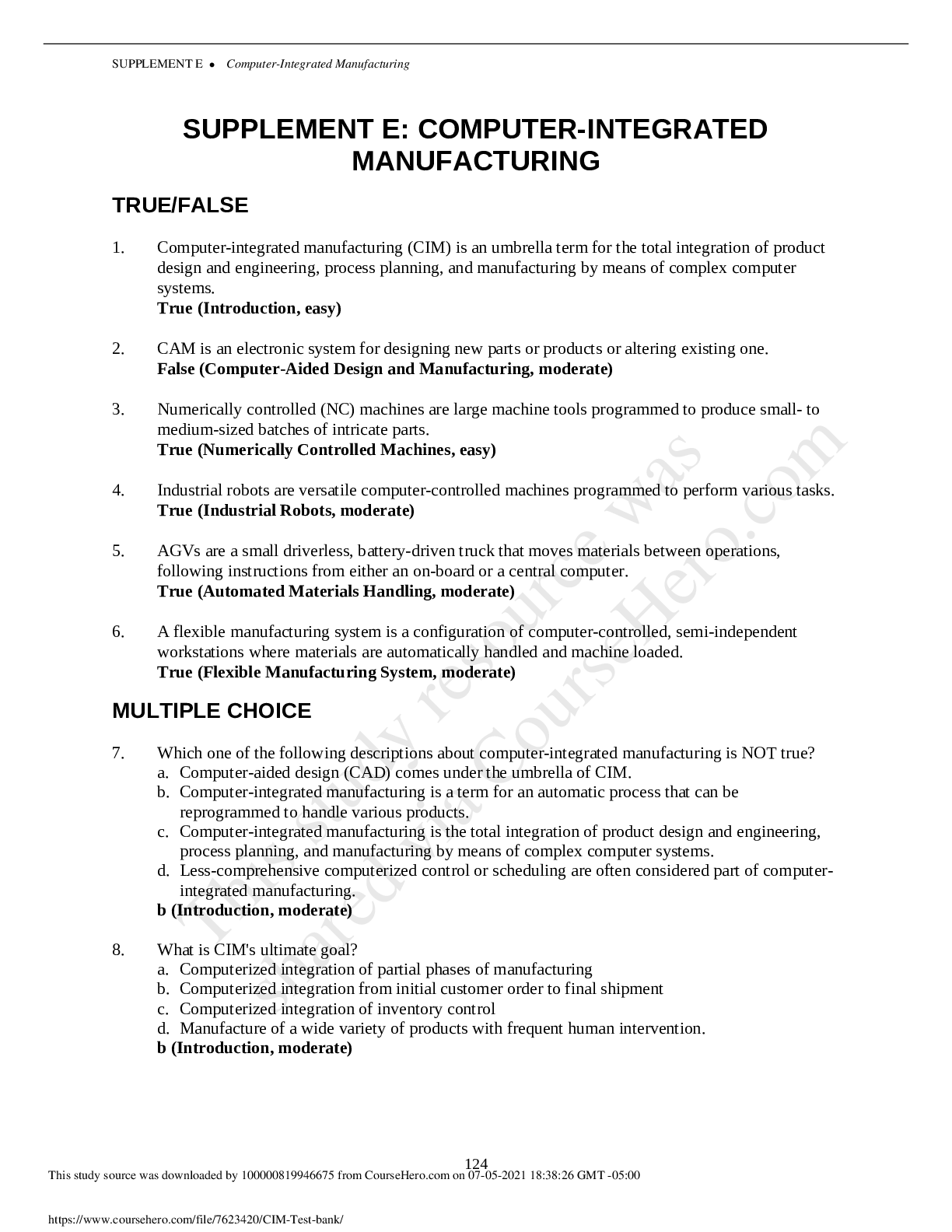
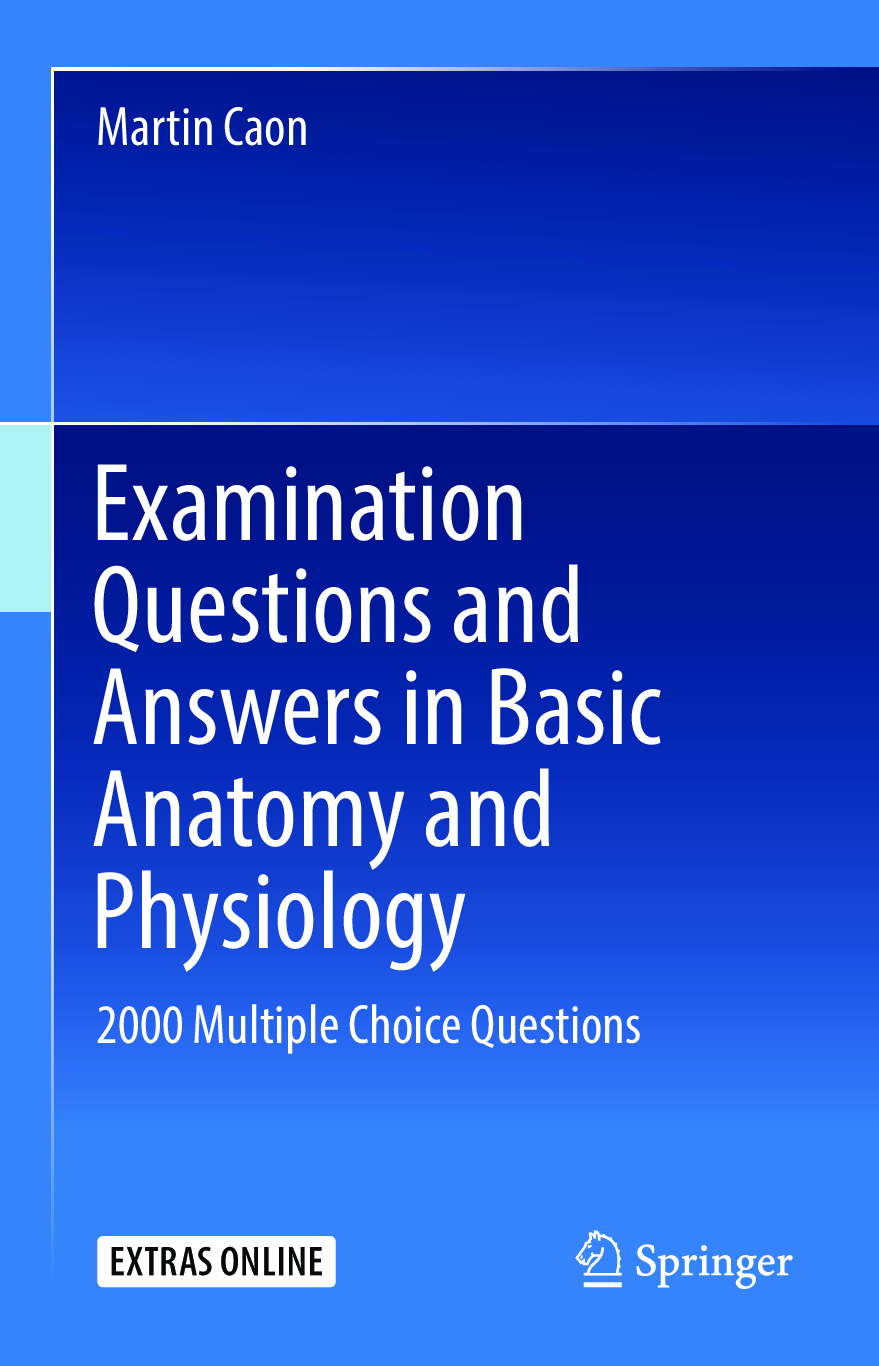
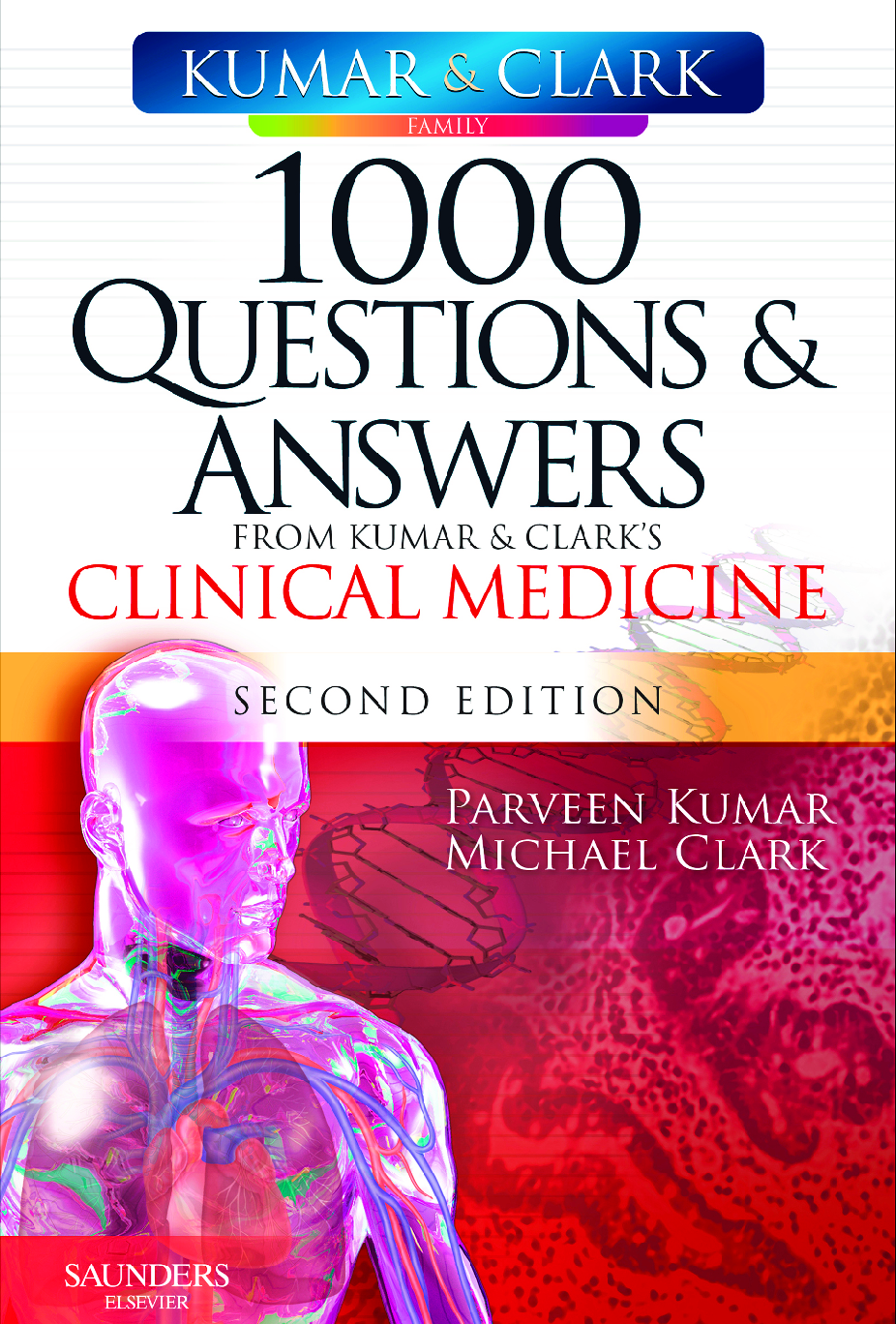
.png)
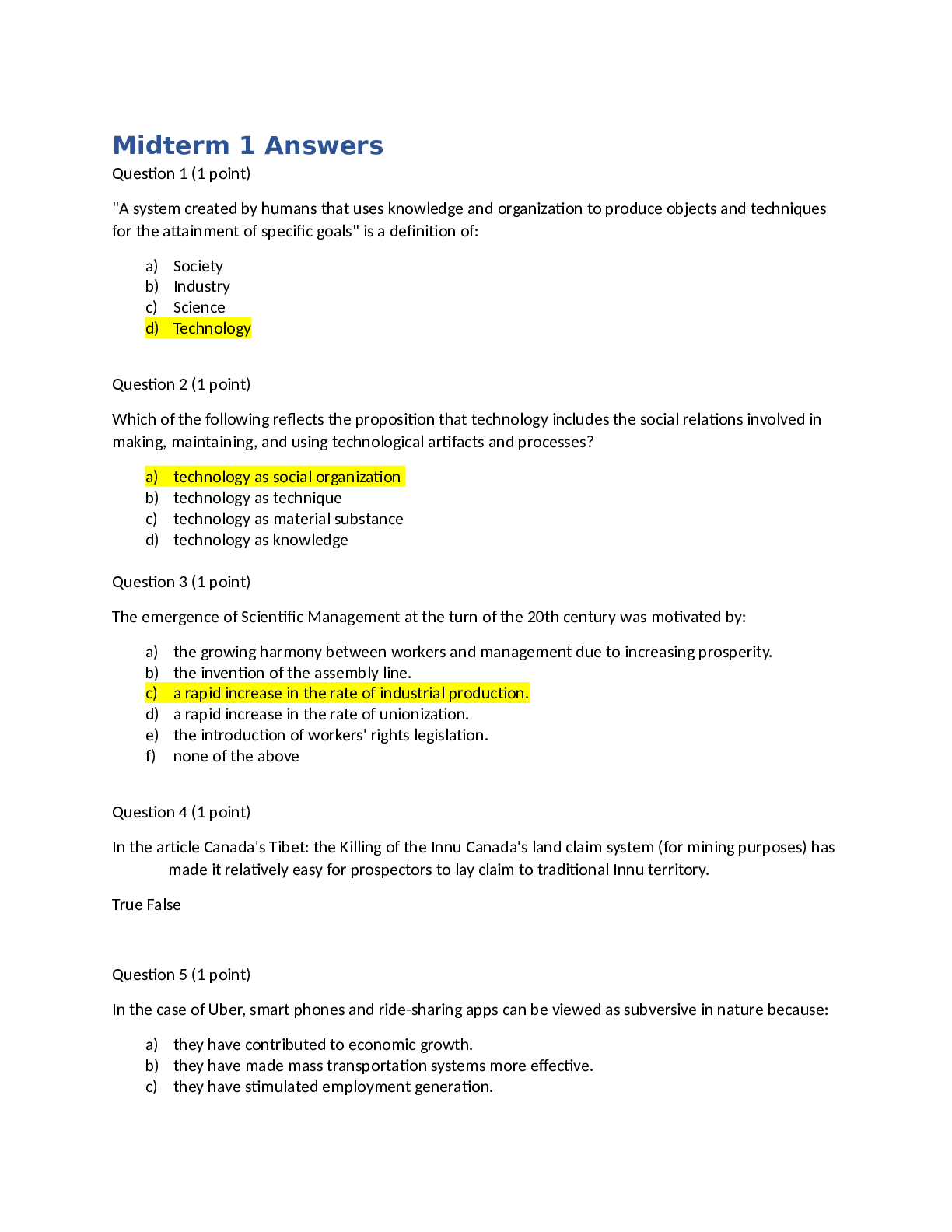

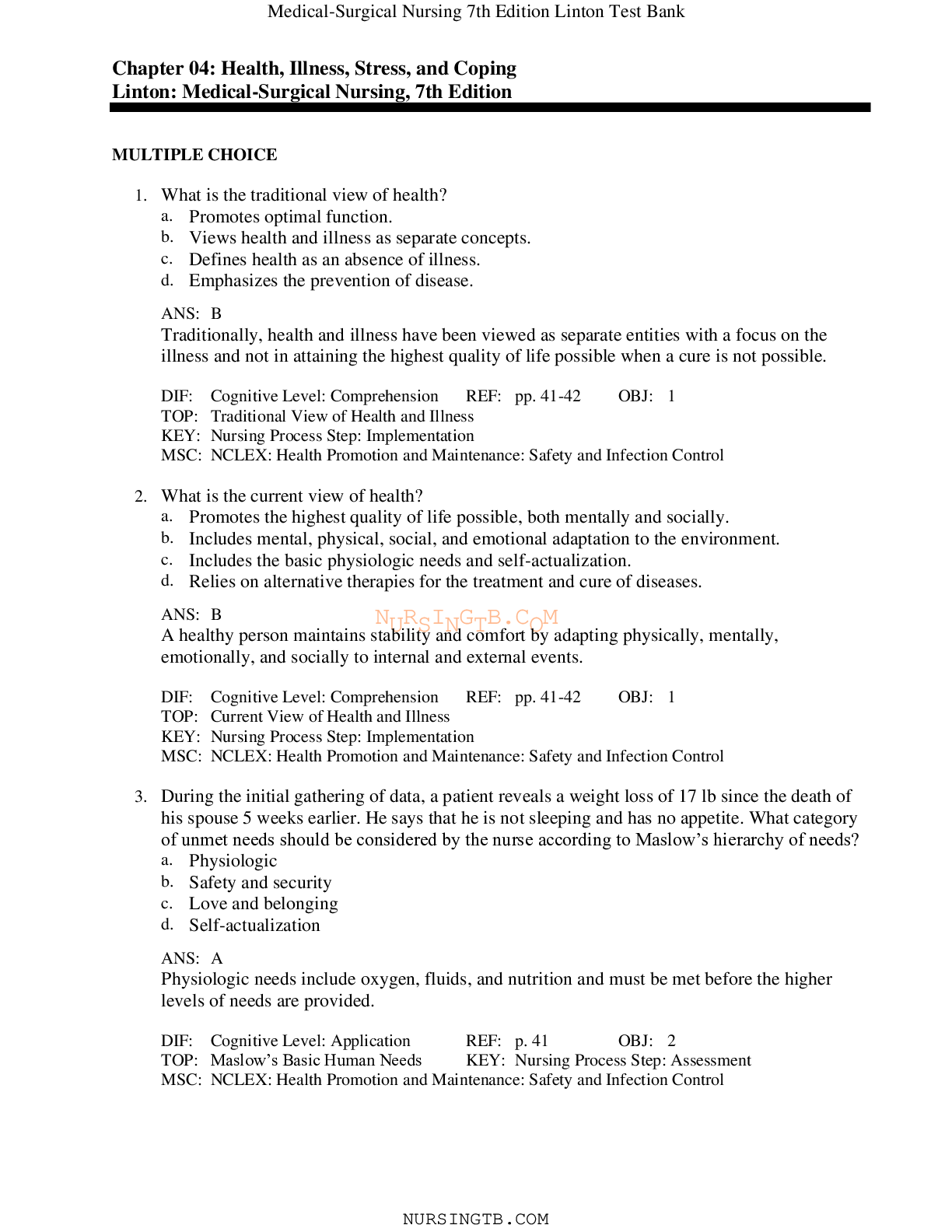
 David L.png)
.png)
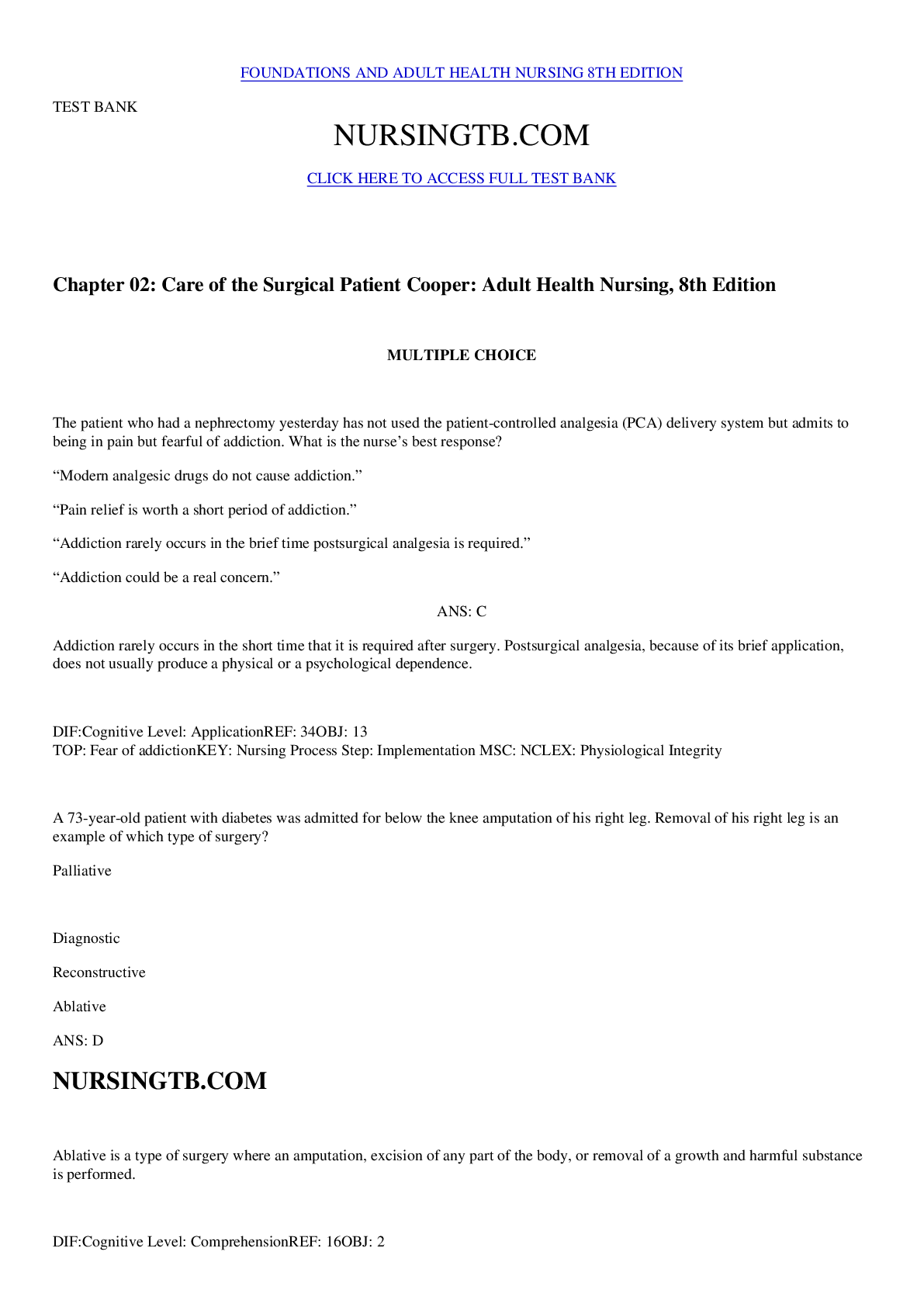
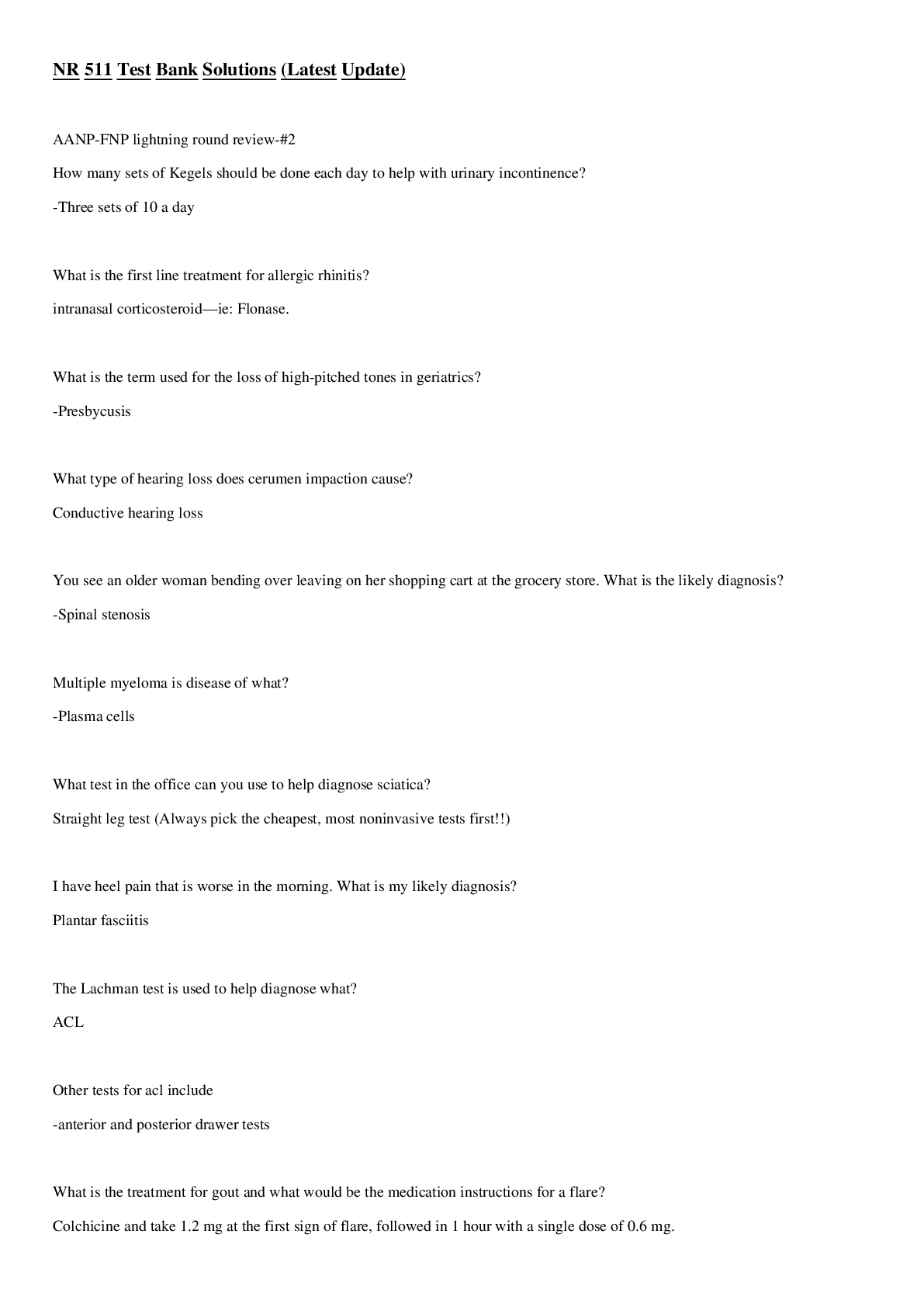



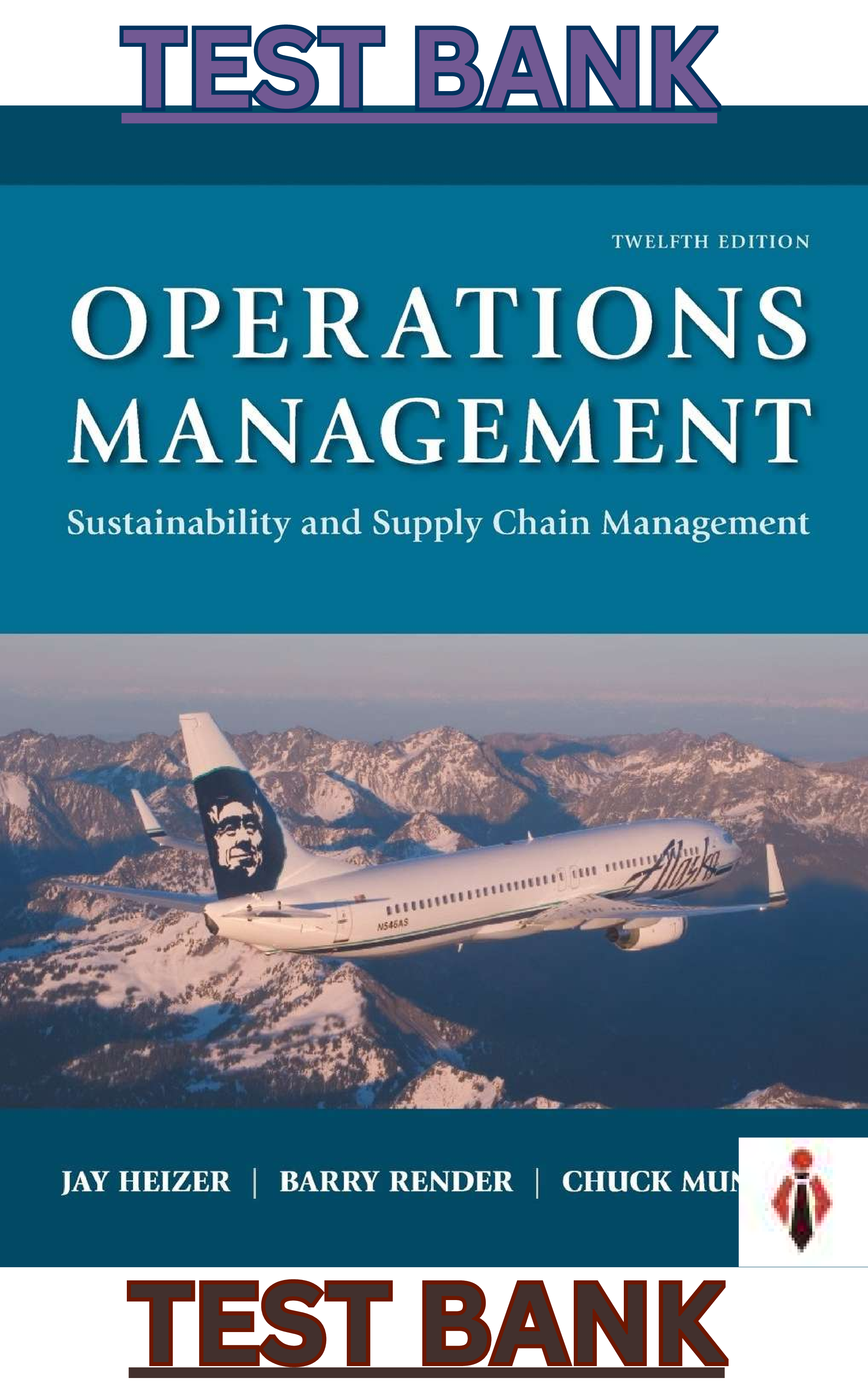
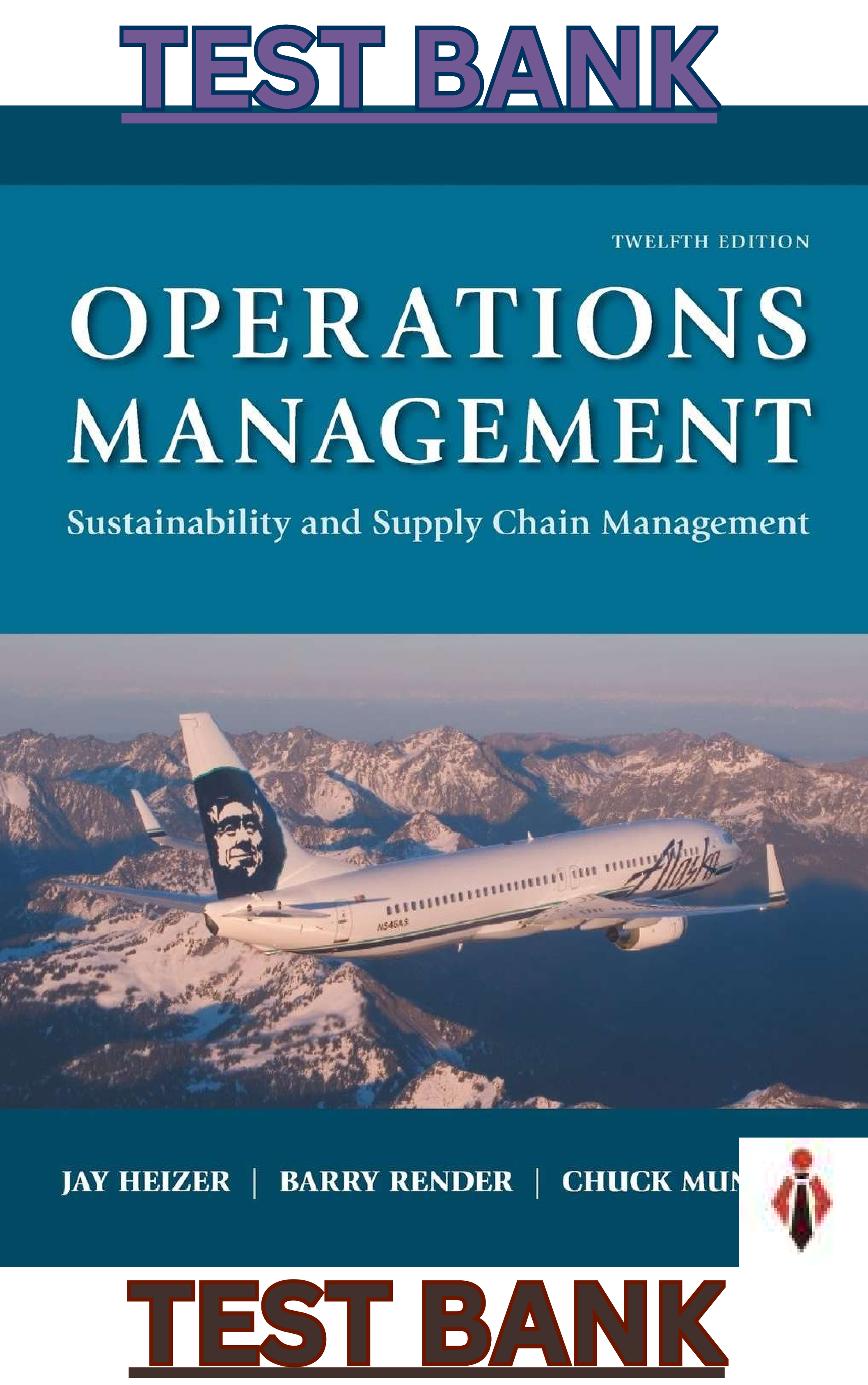
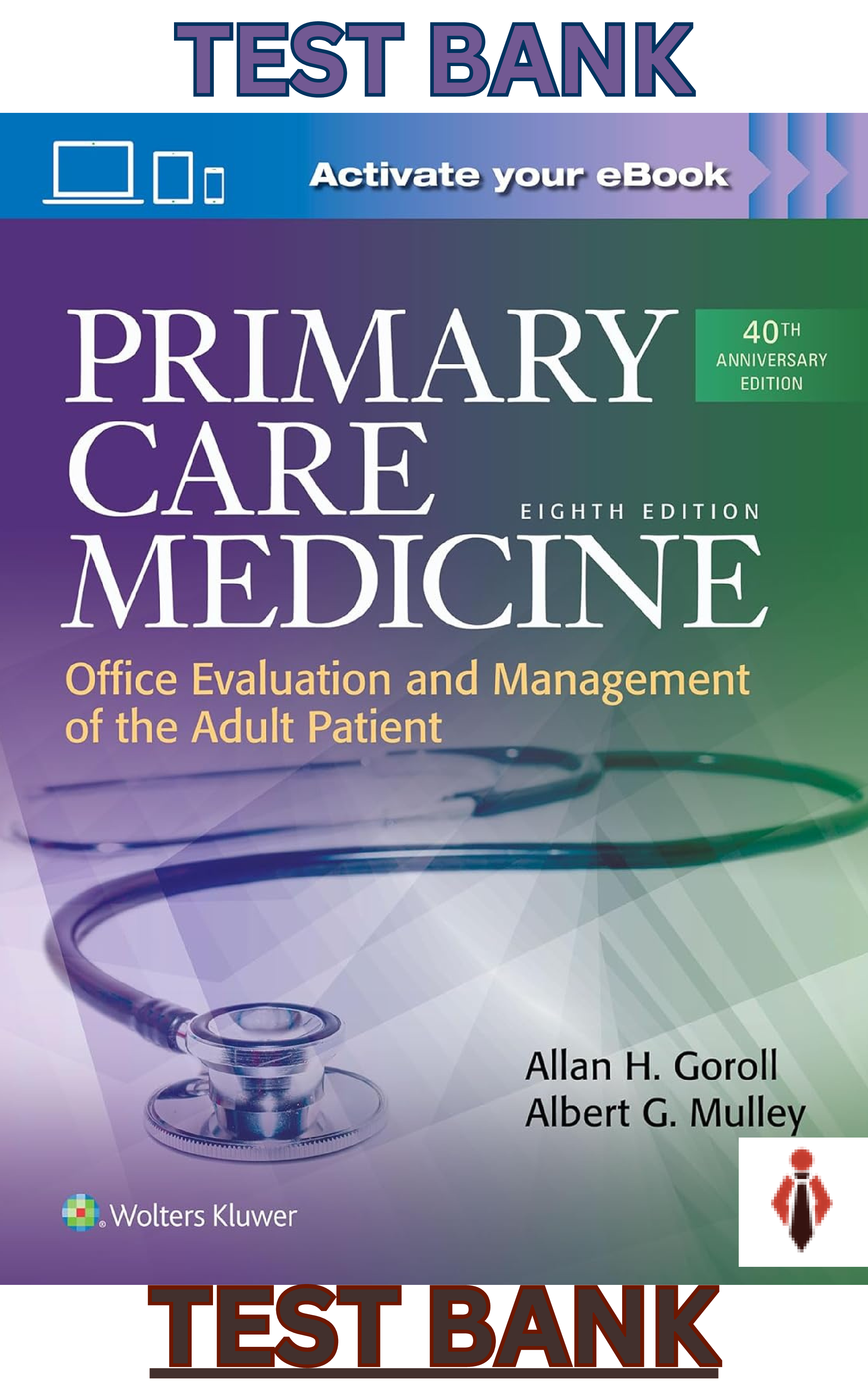

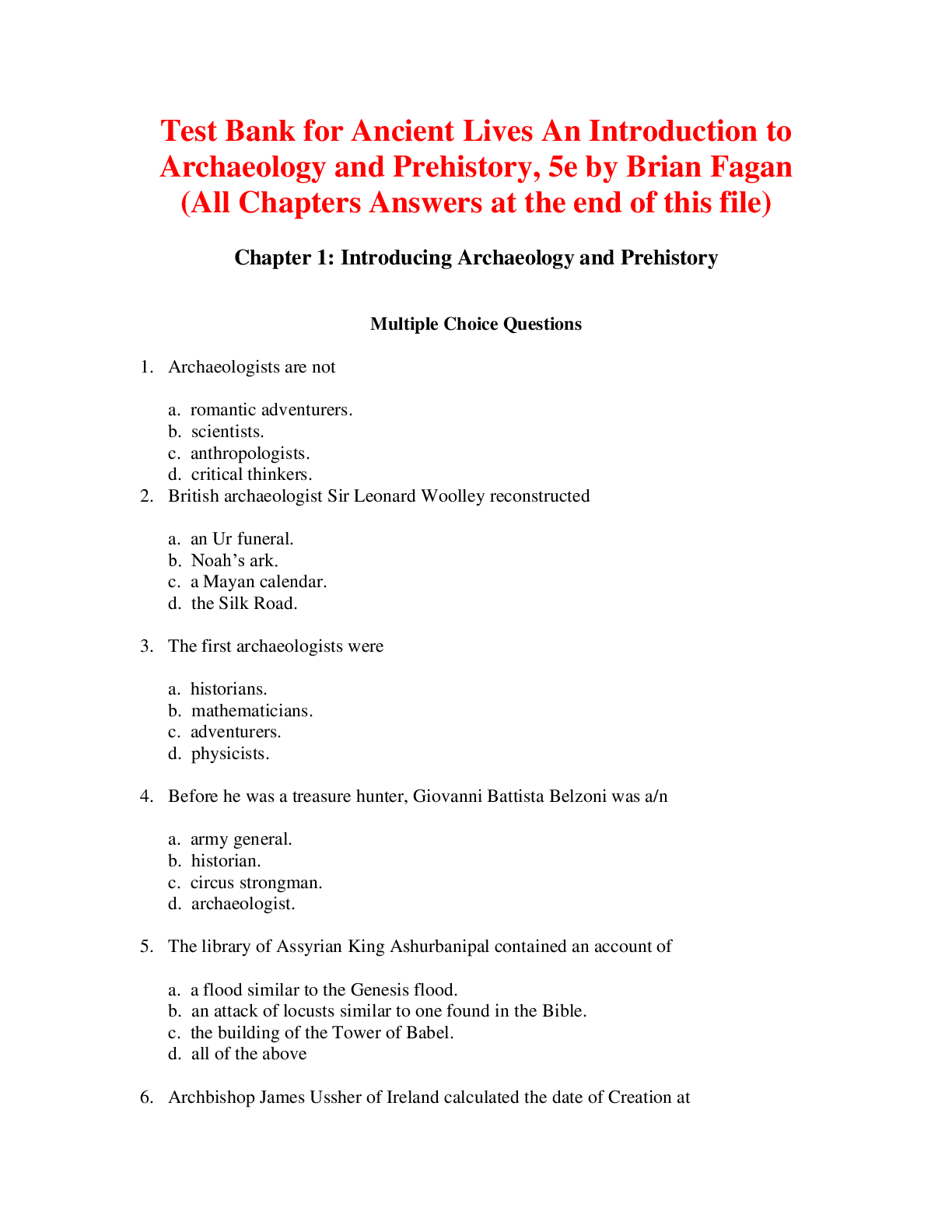
.png)

